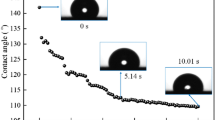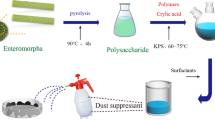Abstract
Aiming at the problems of complex environment and serious dust pollution in large open-pit coal yards, a dust suppression gel with a dual network structure was prepared by modifying the soluble starch and sodium alginate with iron ions. The changes of functional groups, thermal stability, and morphology structure before and after the reaction were analyzed by FTIR, TG-DSC, and SEM, and the formation mechanism of the dual network was revealed by XPS. Furthermore, the water absorption and water retention experiments proved that the dual network structure is more conducive to water retention than the single-layer network. According to molecular dynamics simulations and contact angle experiments, gel and adsorbed water molecules can approach coal dust molecules on their own to contact, wet, and combine with coal dust. The adhesion test proved that the dust suppression gel with iron ions had better adhesion to dust. The anti-freezing test shows that the dust suppression gel has good anti-freezing performance. The antifreeze test shows that the dust suppression gel still has excellent freeze–thaw resistance at the test temperature of -20℃. The mechanical property test shows that the dust suppressant gel can prevent the product from being damaged by external force. The acid and alkali resistance experiments showed that the acid and alkali resistance of the gel was improved under the condition of iron ion modification, and the flying of coal powder was effectively prevented. This research provides a new theoretical idea for coal dust control in complex environment.















Similar content being viewed by others
Data availability
Not applicable.
References
Bao Q, Nie W, Liu C, Zhang H, Wang H, Yan J, Liu Q (2019) The preparation of a novel hydrogel based on crosslinked polymers for suppressing coal dusts. J Clean Prod 249:119343
Chen Y, Xu G, Huang J, Eksteen J, Liu X, Zhao Z (2019) Characterization of coal particles wettability in surfactant solution by using four laboratory static tests. Colloids Surf A Physicochem Eng Asp 567:304–312
Chen Z, Wu Y, Huang S, Wu S, Gao J (2020) Coking behavior and mechanism of direct coal liquefaction residue in coking of coal blending. Fuel 280:118488
Ding J, Zhou G, Liu D, Jiang W, Dong X (2020) Synthesis and performance of a novel high-efficiency coal dust suppressant based on self-healing gel. Environ Sci Technol 54:7992–8000
Guo X, Tang Y, Wang Y, Eble CF, Finkelman RB, Li P (2020) Evaluation of carbon forms and elements composition in coal gasification solid residues and their potential utilization from a view of coal geology. Waste Manag 114:287–298
Hall NB, Blackley DJ, Halldin CN, Laney AS (2019) Current review of pneumoconiosis among US coal miners. Curr Environ Health Rep 6:137–147
Han W, Zhou G, Gao D, Zhang Z, Wei Z, Wang H, Yang H (2019) Experimental analysis of the pore structure and fractal characteristics of different metamorphic coal based on mercury intrusionnitrogen adsorption porosimetry. Powder Technol 362:386–398
Han W, Zhou G, Zhang Q, Pan H, Liu D (2020) Experimental study on modification of physicochemical characteristics of acidified coal by surfactants and ionic liquids. Fuel 266:116966
Han W, Zhou G, Wang J, Jiang W, Zhang Q, Kong Y, Miao Y (2021) Experimental investigation on combined modification for micro physicochemical characteristics of coal by compound reagents and liquid nitrogen freeze-thaw cycle. Fuel 292:120287
Hu H, Wang YL, Wu LY, Zhang YW, Wei WJ, Li HY (2018) Preparation and application of compound antifreeze dust inhibitor. Shandong Chem Ind 47:22–24
Inyang HI, Bae S, Pando MA (2016) Contaminant dust suppression materials: a cost-effectiveness estimation methodology. Measurement 93:563–571
Jiang W, Zhou G, Wang C, Xue Y, Niu C (2020) Synthesis and self-healing properties of composite microcapsule based on sodium alginate/melamine-phenol–formaldehyde resin. Constr Build Mater 271:121541
Jiang W, Zhou G, Duan J, Liu D, Tian F (2021) Synthesis and characterization of a multifunctional sustained-release organic–inorganic hybrid microcapsule with self-healing and flame-retardancy properties. Appl Mater Interfaces 13:15668–15679
Li Q, Lin B, Zhao S, Dai H (2013) Surface physical properties and its effects on the wetting behaviors of respirable coal mine dust. Powder Technol 233:137–145
Li SL, Zhou G, Liu ZQ, Wang NG, Wei ZY, Liu W (2020) Synthesis and performance characteristics of a new ecofriendly crust-dust suppressant extracted from waste paper for surface mines. J Clean Prod 258:120620
Liu Y, Wang M, Zhao S, Liu Y, Yang J (2018) Synthesis and modification of hyperbranched polyester dust suppressant. J Shandong Univ Sci Technol (Natural Science) 37:26–34
Liu L, Ma W, Wang W (2020) Dual damage mechanism of supercritical CO2 adsorption- induced weakening effect on coal. J Shandong Univ Sci Technol (Natural Science) 39:79–86
Liu R, Zhou G, Wang C, Jiang W, Wei X (2020) Preparation and performance characteristics of an environmentally-friendly agglomerant to improve the dry dust removal effect for filter material. J Hazard Mater 397:122734
Medeiros MA, Leite CMM, Lago RM (2012) Use of glycerol by-product of biodiesel to produce an efficient dust suppressant. Chem Eng J 180:364–369
Song S, Zhou G, Duan J, Zhang L, Gao D, Sun B (2021) Numerical simulation investigation on optimal dust-exhausting airflow volume in fully mechanized caving face of high-gas coal mine. Process Saf Environ Prot 146:853–866
Sun J, Zhou G, Gao D, Wei Z, Wang N (2020) Preparation and performance characterization of a composite dust suppressant for preventing secondary dust in underground mine roadways. Chem Eng Res Des Trans Inst Chem Eng Part A 156:195–208
Sun J, Zhou G, Wang C, Liu R, Miao Y (2021) Experimental synthesis and performance comparison analysis of high-efficiency wetting enhancers for coal seam water injection - ScienceDirect. Process Saf Environ Prot 147:320–333
Tang H, Zhao L, Sun W, Hu Y, Han H (2016) Surface characteristics and wettability enhancement of respirable sintering dust by nonionic surfactant. Colloids Surf A 509:323–333
Wang P, Han H, Liu R, GAo R, Wu G (2020) Effect of outlet diameter on atomization characteristics and dust reduction performance of X-swirl pressure nozzle. Process Saf Environ Prot 137:340–351
Wang C, Zhou G, Jiang W, Niu C, Xue Y (2021) Preparation and performance analysis of bisamido-based cationic surfactant fracturing fluid for coal seam water injection. J Mol Liq 332:115806
Wang L, Liu ZY, Yang HY, Li HT, Yu MG, He T, Luo ZZ, Liu F (2021) A novel biomass thermoresponsive konjac glucomannan composite gel developed to control the coal spontaneous combustion: fire prevention and extinguishing properties. Fuel 306:121757
Wu W (2021) Coupled numerical model of hydraulic fracturing and seepage of soft coal based on elastoplastic damage. J Shandong Univ Sci Technol (Natural Science) 40:69–76
Xie H, Ni G, Xie J, Cheng W, Xun M, Xu Y, Wang H, Wang G (2020) The effect of SDS synergistic composite acidification on the chemical structure and wetting characteristics of coal. Powder Technol 367:253–265
Xu Y, Xiong F (2019) Development of high strength instantly membrane-cover dust suppressor for construction sites. Ind Saf Environ Protect 45:88–91
Xu C, Wang M, Wang H, Ma L, Zhu X, Zhu Y, Zhang Y, Liu F (2019) Experimental investigation of coal dust wetting ability of anionic surfactants with different structures. Process Saf Environ Prot 121:69–76
Yang J, Cao H, Fang W, Tan T (2007) Application and appreciation of chemical sand fixing agent-poly (aspartic acid) and its composites. Environ Pollut 150:381–384
Zhang Q, Zhou G, Hu Y, Xing M, Zhang R, Wang P, Hu S (2021) Microwetting dynamic behavior and mechanism for coal dust based on low field NMR method—A case study. Fuel 297:120702
Zhou Q, Qin B, Wang J, Wang H, Wang F (2018) Experimental investigation on the changes of the wettability and surface characteristics of coal dust with different fractal dimensions. Colloids Surf A 551:148–157
Zhou G, Ding J, Ma Y, LI S, Zhang M (2020) Synthesis and performance characterization of a novel wetting cementing agent for dust control during conveyor transport in coal mines. Powder Technol 360:165–176
Zhou G, Xing M, Wang K, Wang Q, Xu Z, Li L, Cheng W (2022) Study on wetting behavior between CTAC and BS-12 with gas coal based on molecular dynamics simulation. J Mol Liq 357:118996
Zhu ZC, Li Y, Xu H, Peng X, Chen YN, Shang C, Zhang Q, Liu JQ, Wang HL (2016) Tough and thermosensitive poly(n-isopropylacrylamide)/graphene oxide hydrogels with macroscopically oriented liquid crystalline structures. Acs Appl Mater Inter 8:15637–15644
Funding
This work was financially supported by the National Natural Science Foundation of China (grant nos. 51904171, 52004150), the Qingchuang Science and Technology Project of Universities in Shandong Province, China (grant no. 2019KJH005), the Science and Technology Project of Qingdao City, China (grant no. 20-3-4-2-nsh), the Outstanding Young Talents Project of Shandong University of Science and Technology (grant no. SKR22-5-01), and the Basic Research on Air Purification and Occupational Health of Coal Mines in Shanbei Mining Area & Key Technical Equipment and Demonstration (grant no. SMHLL-JS-YJ-2020006).
Author information
Authors and Affiliations
Contributions
Meiyue Liu: conceptualization, methodology, writing- original draft preparation, writing—review & editing. Qunzhi Meng: investigation, formal analysis. Chenxi Niu: data curation. Yuying Wang: resources, validation. Gang Zhou: conceptualization, supervision, project administration, funding acquisition. Cuicui Xu: software. Yejiao Liu: visualization.
Corresponding author
Ethics declarations
Ethics approval and consent to participate
Not applicable.
Consent for publication
Not applicable.
Competing interests
The authors declare no competing interests.
Additional information
Responsible Editor: Philippe Garrigues
Publisher's note
Springer Nature remains neutral with regard to jurisdictional claims in published maps and institutional affiliations.
Rights and permissions
About this article
Cite this article
Liu, M., Meng, Q., Niu, C. et al. Preparation and characterization of modified dual network dust suppression gel based on sodium alginate and soluble starch. Environ Sci Pollut Res 29, 69771–69784 (2022). https://doi.org/10.1007/s11356-022-20721-0
Received:
Accepted:
Published:
Issue Date:
DOI: https://doi.org/10.1007/s11356-022-20721-0




